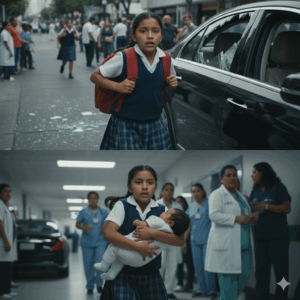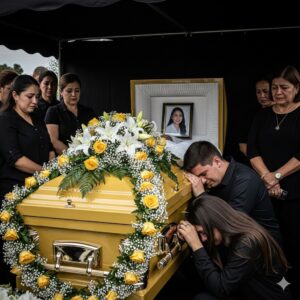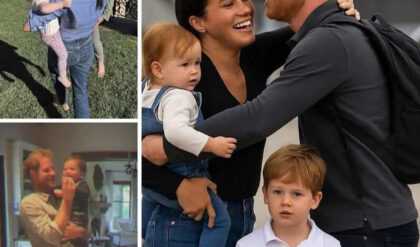On September 15, 2017, at 11 a.m. in a working-class neighborhood of Monterrey, a scream was heard that paralyzed all the residents of Juárez Street, a scream that contained 15 years of pain, hope, and a persistence that had defied all odds.
María Teresa Morales had just found her daughter Ana after a decade and a half of tireless searching. Ana Morales, who disappeared when she was 19 years old, now 34, was alive in a hidden room inside the house of Rogelio Fernández, the neighbor who lived just 50 meters from her family home. The same man who during all those years had offered help in the searches, had asked about the progress of the investigation and had consoled María Teresa in the most difficult moments.

Ana was emaciated, disoriented, with premature gray hair and a look that reflected years of confinement. But when she saw her mother, her eyes filled with tears and she murmured the words Maria Teresa had dreamed of hearing for 15 years. Mom, I knew you were going to find me.
The news traveled through Mexico in a matter of hours. Questions arose immediately. How had it been possible to keep a person kidnapped for 15 years in a neighborhood where everyone knew each other? Why had the investigation never suspected the nearest neighbor? The Morales case would become one of the most shocking in Mexico’s criminal history, not only because of the length of captivity, but because of the demonstration that maternal love can transcend any obstacle, even when all authorities and society have lost hope. But to understand this story
We need to go back to the moment when it all began. An apparently normal afternoon in September 2002, when Ana Morales left her house to buy milk and never returned. The Santa María neighborhood in the northeast sector of Monterrey was during 2002 the type of neighborhood where the doors remained open during the day.
Children played freely in the streets and mothers knew each other by their first names, a place where the disappearance of any neighbor immediately became a problem for the entire community. It was precisely this atmosphere of proximity and mutual surveillance that made it unthinkable that anyone could disappear without a trace.
Ana Morales had grown up in that neighborhood since she was 5 years old, when María Teresa moved there after separating from the father of her children. The family home occupied a quiet corner of Juárez Street, a modest two-bedroom building where María Teresa grew medicinal plants that she sold at the local market to supplement her income as a domestic worker.
By the age of 19, Anne had developed a reserved but responsible personality. She preferred to spend the afternoons helping her mother with household chores, sewing clothes to order for neighbors or taking care of her younger siblings, Jorge, 15, and Patricia, 12.
Her routine was predictable and reassuring for a single mother who worked long hours outside the home. Ana would get up early to prepare the family’s breakfast. She accompanied her siblings to school, returned to do housework, and in the afternoons she engaged in sewing projects that generated additional income.
Neighbors described her as a serious, hard-working young woman who greeted her politely, but did not participate in neighborhood gossip or conflicts. He was the kind of person who disappears without generating theories about secret boyfriends, dangerous debts, or hidden enmities. Maria Teresa had built a solid reputation in the colony during nearly 15 years of residency. She worked as a maid for three middle-class families, cleaning large houses with the meticulousness she had learned during her childhood.
The income was not abundant, but it was enough to support their children fed, clothed and studying. His relationship with Anne was particularly close. As the eldest child and only female in the family, Ana had assumed maternal responsibilities with her siblings from an early age. Maria Teresa depended on her not only for household chores, but also as a confidant and emotional support.
“Ana is my right arm,” María Teresa used to say to the neighbors. Without her, I wouldn’t know how to handle everything on my own. This healthy codependency made it completely unthinkable that Anne would decide to voluntarily leave the family home. She knew the economic difficulties her mother faced.
She knew that Jorge and Patricia needed constant supervision and understood that their absence would leave Maria Teresa in a desperate situation. September 18, 2002 began like any other Tuesday at the Morales house. María Teresa said goodbye to her children at 6:30 in the morning, as she had done for years. He kissed Ana on the forehead, reminded her to take good care of her siblings and promised to return before 7 p.m.
It was the last time she saw her daughter walking freely around her own house. The routine of September 18 developed normally until 4:30 in the afternoon, when Ana realized that there was not enough milk to prepare the coffee with milk that Jorge and Patricia drank with the snack.
It was a minor situation, but one that required an immediate solution. Ana put away the sewing work she had been doing. He took 20 pesos of the money that María Teresa had left for the day’s expenses and went to the front door. I’m going to get milk at Don Aurelio’s store,” he shouted to his brother Jorge, who was playing in the backyard. “I’ll be back in 10 minutes.” Jorge responded with a distracted gesture.
Later, those would be the last words she would hear from her sister for 15 years. Don Aurelio’s store was located four blocks from the Casa de los Morales, on a busy corner where three public transportation routes converged. It was a family business that had been serving the Santa María neighborhood for more than 20 years.
The journey from the house to the store was completely familiar to Ana. He had traveled that route hundreds of times, both day and night, without ever experiencing safety problems. Don Aurelio would later remember that Ana arrived at his store at approximately 5:15 in the afternoon. He bought a liter of whole milk, paid with a 20-peso bill and received 8 pesos in change. The transaction lasted less than 3 minutes, and Ana showed no signs of concern.
He looked normal as always, Don Aurelio would declare to the authorities weeks later. He greeted me, bought the milk, asked me how my wife was doing and said goodbye cordially. According to multiple testimonies from neighbors, Ana left the store at approximately 5 p.m., walking in the direction of her house along the usual route.
Three people confirmed seeing it during the first two minutes of the journey. Mrs. Maldonado, who was sweeping in front of her house, the young Raúl Ibarra, who was waiting for the bus, and the girl Carmen Soto, who was playing at the gate of her house.
Everyone agreed that Ana was carrying a plastic bag with milk, walked at a normal pace and did not seem to be being followed by anyone. However, Ana Morales never arrived home. Jorge began to worry at 5:30 when his sister had not returned after almost an hour of absence for a task that usually took 10 minutes. Patricia came home from school at 6 and immediately asked for Ana.
At 6:30, Jorge decided to walk the route to Don Aurelio’s store to look for his sister. he found the business working normally, but Don Aurelio confirmed that Ana had been there and had left more than an hour before.
Jorge carefully walked the four blocks between the store and his home, checking adjacent streets, asking neighbors and even exploring the small park where some young people occasionally gathered. He found no trace of Ana or the liter of milk he had bought. Concern turned to alarm when Maria Teresa returned from work at 7 p.m. and found Jorge and Patricia waiting for her with expressions of anxiety.
Where is Ana? That was María Teresa’s first question when she saw her youngest children alone in the house. We don’t know, Mom, Jorge replied with a broken voice. She went to buy milk at 5 and never returned. Maria Teresa felt the world stop around her. In 15 years of living in the Santa María neighborhood, in 19 years of knowing her daughter, Ana had never disappeared without warning.
She was a young woman of predictable routines, clear responsibilities, and constant communication with her family. Something terrible had happened during those four blocks between Don Aurelio’s store and the family home. But what? How and why remained unanswered questions that would torture Maria Theresa for the next 15 years? The first theory that dominated both the official investigation and the speculations in the neighborhood pointed to an express kidnapping carried out by criminals who had mistaken Ana for a young woman from a wealthy family. Era
2002 and Monterrey was experiencing a worrying increase in this type of crime. The hypothesis gained strength because Ana, despite belonging to a family of limited resources, had an appearance that could have generated confusion in kidnappers who observed her superficially. She was a well-groomed young woman, always wearing clean and ironed clothes and walked with the confidence of someone used to moving around her neighborhood without worries.
Researcher Carlos Mendoza, initially assigned to the case, developed a specific theory. It is likely that a criminal group has identified the young woman as a potential target, without adequately investigating her real economic situation. When they realized the error, they possibly decided to delete it to avoid being identified. This theory explained the total absence of contact after the abduction.
In cases of traditional kidnapping, criminals establish communication with the family to negotiate ransom. In Ana’s case, no call ever came requesting money. María Teresa found some logic in this explanation during the first months of searching. it allowed him to maintain hope that Ana was still alive, held in some remote place by criminals who would eventually release her when they confirmed that the family could not pay ransom.
The second important theory arose from comments by some neighbors about an unknown car that had been seen circulating in the neighborhood during the days prior to the disappearance. Mrs. Maldonado recalled noticing a gray sedan with license plates that she could not memorize, occupied by two men who seemed to observe the routines of the neighborhood.
“I didn’t give them importance at the time,” Ms. Maldonado told investigators. I thought they might be relatives of a new neighbor or maybe vendors, but now that I think about it, it seemed strange to me that they stayed so long without getting out of the car. This information generated an intensive search for witnesses who could provide additional details about the suspect vehicle.
For several weeks, the investigation focused on locating similar cars, reviewing records of vehicle thefts and constructing spoken portraits of the occupants. The suspicious car theory kept investigators busy for nearly 6 months, but never produced concrete clues leading to Ana.
The spoken portraits did not match known criminals in the police database. The third theory, more painful for María Teresa, but equally persistent, suggested that Ana had decided to voluntarily abandon her life in Monterrey to start a new existence in another city. Some researchers argued that a 19-year-old with overwhelming family responsibilities and few opportunities for personal development could have secretly planned an escape.
“We have seen similar cases,” Investigator Mendoza explained to María Teresa. Young people who feel the weight of family expectations and decide to seek independence without painful confrontations. Maria Theresa categorically rejected this possibility. Ana would never have done something like that to me.
She knew how much Jorge and Patricia needed her and above all she loved me too much to cause me this suffering. These three main theories dominated the investigation for the first two years after Ana’s disappearance. Each had compelling elements, but also significant gaps that prevented conclusive progress. What no theory contemplated was the simplest and at the same time most unthinkable possibility, that Ana Morales had never really left the Santa María neighborhood and that during the entire time of the search she had remained less than
100 met from the house where Maria Theresa mourned his absence every night. By 2007, 5 years after Ana’s disappearance, the official investigation had practically reached a standstill. The case files occupied three complete folders in the offices of the Ministerial Police, but the active leads had been exhausted without producing tangible results. María Teresa had completely transformed her life based on the search for Ana.
She had reduced her working hours as a domestic worker to spend more time visiting government offices, organizing search campaigns and keeping the media attention on the case alive. Her income had decreased considerably, but she had developed a support network between neighbors and civil organizations.
Jorge, now 20, had dropped out of high school to work full-time to make up for the reduction in family income. He had become a serious and responsible young man, but also bitter about the absence of his sister. Patricia, 17, showed signs of adolescent depression aggravated by the constant tension in the family home.
Mom, you have to accept that maybe Ana is not going to come back. Jorge had told her during a particularly painful conversation. It’s been 5 years. We cannot continue to live as if it were going to appear tomorrow. Maria Theresa had been infuriated by that suggestion. How can you say that? Ana is your sister.
As long as I have life, I will continue to look for it. However, in the privacy of her bedroom, during the sleepless nights that had become routine, Maria Teresa struggled with doubts that tormented her and whether Ana had really decided to leave voluntarily and whether the whole search was a futile exercise that was destroying what was left of her family.
Rogelio Fernández, the neighbor who lived 50 meters from the Morales, had shown during all those years a discreet but constant support for María Teresa. Occasionally he would come to ask about the progress of the investigation, offer help to put up posters in remote areas of the colony or express words of encouragement during the most difficult moments.
Don’t lose faith, Mrs. Maria Theresa,” Rogelio told her when he found her particularly discouraged. “Mothers have a special connection with their children. If Anne were dead, you would feel it. The fact that she holds hope means that she is still alive somewhere.” Rogelio had gradually established a more noticeable presence in the daily life of the colony.
He had begun offering minor domestic repair services that allowed him to legitimately enter his neighbors’ homes. He was a skilled man, charged fair prices and did quality work. Their house, a one-story building slightly larger than the surrounding dwellings, had become a minor landmark in the neighborhood.
Over the years, Rogelio had built a makeshift workshop in the backyard, where he repaired household appliances. The sound of tools in the evenings had become part of the normal soundscape of the street. María Teresa had developed a genuine gratitude towards Rogelio mixed with the familiarity of years of neighborly coexistence. He had proven to be one of the few people who had never lost interest in finding Ana.
I had never questioned Maria Teresa’s decision to continue waiting. During 2007, Maria Teresa began to experience what she would later describe as soul fatigue. The constant searching, the hope maintained against all evidence, and the strain of supporting a fractured family had begun to take their toll physically and emotionally. Their savings had been completely depleted.
His health showed signs of deterioration. He had developed high blood pressure, suffered from chronic headaches, and had lost almost 15 kg over the past 2 years. Join us on this channel. Subscribe and share your opinion in the comments. The moment that would change everything came in the most unexpected way possible during the second week of September 2017, exactly 15 years after Ana’s disappearance.
It all began with a routine inspection of the municipal health department in the Santa María neighborhood. Several neighbors had filed complaints about strange odors coming from different homes, drainage problems and suspicions of unauthorized construction that could be violating urban regulations. The inspection had been scheduled to review 15 homes on Juarez Street, including the property of Rogelio Fernandez.
Maria Teresa had learned of the inspection through Mrs. Garcia, who had commented that the inspectors would arrive on Tuesday morning for reasons that she herself would not be able to fully explain, Maria Teresa felt an inexplicable urgency to accompany the inspectors when they checked Rogelio’s house.
“I don’t know why, but I feel like I must be there,” she confided to her neighbor the night before. During all these years, Don Rogelio has been very good to me. I want to make sure that he does not have problems with the authorities. On Tuesday, September 12, 2017, at 10 a.m., María Teresa appeared at the municipal office to request permission to accompany the inspection as a representative of the neighborhood committee.
The chief inspector, Ramón Herrera, agreed when María Teresa explained her personal situation and her knowledge of the history of the colony. The inspection of Rogelio’s house was scheduled for 11:30. When Maria Teresa and the three inspectors arrived at the property, they found Rogelio, evidently nervous, but cooperative. He had prepared all the documents related to his housing and seemed eager to quickly complete the process.
“Good morning, Mrs. María Teresa,” Rogelio greeted with a smile that did not reach his eyes completely. I didn’t know that you were going to accompany the inspection. The review began routinely. Inspectors checked electrical installations, checked the drainage system, and examined the overall condition of the construction.
Everything seemed to be in perfect order until they reached the backyard, where Rogelio had built his makeshift workshop. Inspector Herrera noted that the dimensions of the workshop did not exactly match the original plans of the property and that there appeared to be an unauthorized extension. Mr. Fernandez, we need to check the back of the workshop, the inspector reported.
The plans we have do not show this additional construction. Rogelio began to show obvious signs of nervousness. His hands trembled slightly as he searched for keys in his pockets and his breathing had visibly quickened. “It’s just a storage room,” he explained in a voice that had lost its naturalness. I keep tools that I don’t use often.
I don’t think it needs to be checked because it doesn’t have electrical or water connections. However, Inspector Herrera was meticulous in his work and insisted on verifying all the constructions. Rogelio tried to delay the review arguing that he had lost the key to the room, but the inspectors decided to proceed by forcing the lock if necessary.
It was at that moment that Maria Teresa heard something that would forever change the course of her life. While Rogelio was arguing with the inspectors about the need to check the back room, a sound came from inside the enclosed space that should not have existed. The distinctive noise of someone moving, followed by what appeared to be a choked cough. Maria Teresa felt the world stop around her.
For 15 years she had developed an almost supernatural auditory sensitivity for any sound that might relate to Ana. But this sound was different. It was not the product of an imagination tortured by hope. The inspectors had heard him too. Is there anyone in there? Inspector Herrera asked Rogelio directly.
No, there is no one, Rogelio replied with a desperation that he could no longer hide. It must be some animal that got in. But at that moment another sound was heard that no animal could have produced. A human voice, weak and distorted, but unmistakably human, that seemed to be asking for help.
Maria Teresa approached the closed door of the room and following an impulse that had been growing for 15 years, she shouted with all the strength of her lungs, Ana, Ana, are you there? The answer that came from within was confirmation of a miracle that had waited for more than 5,000 days. Mom, mom, it’s me. The next 30 minutes were a whirlwind of emotions, actions, and revelations that defied any rational understanding of what had been going on for 15 years in the Santa María neighborhood. Inspector Herrera immediately requested police reinforcements by radio while
his companions were in charge of controlling Rogelio, who had entered a state of total panic. Maria Theresa had begun to knock desperately on the door of the locked room, shouting Anne’s name and promising to get her out of there immediately. “Ana, my girl, I’m coming for you.
I’m here, daughter,” María Teresa repeated, while tears prevented her from seeing clearly. 15 years of pain, hope and desperate search were concentrated in those moments of absolute certainty that her daughter was alive and a few meters away.
From inside the room came breathy answers that confirmed Ana’s identity, but also revealed the devastating state in which she was. Mom, I can’t go out. The door is locked. I’m very weak. Ana’s voice had changed during 15 years of captivity. She was hoarse, more broken, with the slow cadence of someone who had lost the habit of normal conversations.
But Maria Theresa recognized her immediately. The police arrived in less than 10 minutes. The officer in charge, Commander Luis Vega, took control of the situation immediately. He arrested Rogelio, secured the crime scene, and arranged for the careful opening of the room where Anne had been held captive.
When they finally managed to open the door, the scene they found was simultaneously the happiest and most devastating moment in Maria Teresa’s life. She was alive, but the conditions of her survival revealed a systematic cruelty that had lasted more than 5000 days. The room was a makeshift cell about 3 m by 4 m with a small bed, a portable chemical toilet, and a completely sealed window.
The walls showed marks that Anne had made over the years to keep track of time, stripes arranged in groups of five, one for each day of captivity. The numbers reached approximately 5400 marks, visual evidence of the endless time he had lived waiting for this moment. Ana was emaciated, but conscious. Her hair, which had been black and abundant, was now gray and sparse.
Her weight had dropped dramatically and her skin showed the paleness of someone who had lived without sun exposure for years. But when she saw Maria Theresa, her eyes filled with tears and she stretched out her arms with the same confidence she had shown as a child. “Mom, I knew you were going to find me.” These were the first complete words that Ana managed to utter when María Teresa hugged her.
Every day I thought about you. I knew you weren’t going to stop looking for me. The reunion was witnessed by inspectors, police officers and gradually by neighbors who began to arrive attracted by the commotion. The news spread through the Santa María neighborhood like wildfire. Ana Morales, the young woman who disappeared 15 years earlier, had been found alive in the house of the neighbor, who during all that time had comforted her mother.
Jorge and Patricia rushed in from their jobs when they received phone calls that initially seemed impossible to believe. The brother who was now 30 years old and the sister who was 27 came face to face with Ana, whose appearance had changed so much that it was initially difficult to recognize her, but whose smile was still exactly the same.
“Ana, sister, is it really you?” asked Patricia while crying and laughing simultaneously. During all these years, Mom never stopped saying you were alive. I was right. Jorge just hugged Ana and repeated, “We miss you so much, sister. We miss you so much. Paramedics confirmed that Ana had managed to survive without serious permanent physical damage.
She was malnourished, dehydrated, and showed obvious symptoms of depression and anxiety, but her vital signs were stable. The true story of Rogelio Fernández emerged during the days after his arrest, revealing a disturbed personality who had developed for decades an unhealthy obsession with absolute control over other people. Rogelio was not the hard-working, discreet man he had appeared to be.
Behind his façade as a helpful neighbor was an individual with a history of predatory behavior that he had managed to keep hidden through an extraordinary ability to manipulate social perceptions. During the interrogations, Rogelio initially tried to deny responsibility by arguing that Ana had come to his house voluntarily and that he had only protected her from family problems.
However, when the investigators presented him with physical evidence, he gradually began to admit aspects of the truth. I never wanted to hurt him,” Rogelio said during his third interrogation session. Ana was a very beautiful young woman, very hardworking and I thought she could be happy with me. He just needed time to get used to a different life.
This distorted version of events revealed Rogelio’s deeply disturbed mentality. In her perception, the kidnapping and confinement for 15 years had been acts of protection and care for Ana, who had supposedly needed to be saved from a life of poverty and overwhelming family responsibilities.
Ana had been identified as a target for months before her abduction. Rogelio had systematically observed her routines, studied her schedule, and meticulously planned the time and manner to intercept her. “I saw her pass in front of my house every day,” Rogelio admitted during subsequent interrogations.
She was so responsible, so dedicated to her family. I thought that if I gave her a place where she didn’t have financial worries, she would eventually understand that it was better for her. The plan had been executed with a simplicity that explained why it had never been detected by the investigations. On September 18, 2002, Rogelio had waited for Ana to leave Don Aurelio’s store and had simulated a medical emergency near his home.
When Ana approached to offer help, he had drugged her with chloroform and had transferred her unconscious to the previously prepared room. The captivity room had been built for months before the abduction under the pretext of creating storage space. It was completely soundproofed.
It had artificial ventilation that allowed survival, but prevented communication with the outside and had been equipped with basic elements to keep a person alive for indefinite periods. For 15 years, Rogelio had kept Ana in conditions that fluctuated between basic care and systematic psychological abuse.
It provided him with enough food to survive, but he completely controlled his schedules. He allowed him to shower, but he decided when and how. He gave him books to read, but censored any content that might remind him of his previous life. The psychological manipulation was constant and sophisticated.
Rogelio had convinced Ana during the first few years that her family had stopped looking for her, that she had moved out of the colony, and that trying to escape would only result in harm to her and the people who could help her. The days after the rescue were a whirlwind of revelations that gradually pieced together the true story of the darkest 15 years in the Morales family’s life.
Ana’s testimony, carefully collected during multiple sessions with trauma psychologists, revealed details that defied any understanding of the limits of human endurance. For 15 years he had maintained his sanity and hope through mental routines that he had developed to preserve his identity. Every day when I woke up he repeated the names of my mother, Jorge and Patricia,” Ana said.
I remembered important dates, birthdays, the day I disappeared, Christmas. I didn’t want to forget who I was or where I came from. Ana had created a complex system of mental exercises that included remembering cooking recipes she had learned from Maria Theresa, mentally reconstructing the layout of her family home, and imagining detailed conversations with her siblings about how they would have grown during her absence.
She knew that Jorge was going to be a responsible man because he was always a hard worker since he was a child, Ana explained with a smile that contrasted painfully with the circumstances of her story and she knew that Patricia was going to be beautiful and intelligent because she already showed those characteristics when she was 12 years old. However, the testimony also revealed disturbing aspects about the manipulation techniques that Rogelio had employed.
He had used information obtained during his participation in the searches to create false narratives specifically designed to dash Ana’s hope. He told me that my family had moved out of the neighborhood because they couldn’t stand the memories, Ana said.
He showed me newspaper clippings where there was no news about my case and told me that this meant that no one remembered me anymore. However, the strategy had had the opposite effect. Instead of breaking Ana’s resistance, she had strengthened her determination to survive and keep alive the hope of being reunited with her family. Forensic investigations of the room revealed additional evidence that confirmed both the length of confinement and the specific conditions in which Ana had survived.
The markings on the walls showed a mathematical precision that had required extraordinary mental discipline. Investigators also found improvised diaries that Ana had kept for years, written on various materials. These documents offered a unique window into the psychological experience of prolonged captivity.
The investigation also revealed that during the 15 years of captivity, Ana had been physically less than 100 met from her family home. On multiple occasions, María Teresa had walked in front of Rogelio’s house while looking for clues about her daughter’s whereabouts, not knowing that Ana was being held captive inside. Rogelio Fernández’s trial took place between March and June 2018, becoming one of the most followed cases by national media due to the extraordinary duration of the captivity and the unique circumstances of the rescue. Rogelio was sentenced to 60 years in prison.
prison for aggravated kidnapping, illegal deprivation of liberty and multiple charges related to psychological abuse. The sentence was considered one of the most severe ever imposed in Mexico for this type of crime. During the court process, Rogelio showed a complete lack of genuine remorse for his actions.
His final statements revealed that he continued to interpret the kidnapping as an act of protection for Ana. I gave Ana a life without financial worries, without overwhelming responsibilities,” he said during his last opportunity to address the court. I took care of her for 15 years better than her own family could have cared for her.
Ana demonstrated extraordinary psychological strength during the trial. His testimony was clear, detailed, and provided the definitive evidence necessary for the conviction of his captor. However, he also showed a capacity for forgiveness that impressed observers. “I don’t hate Rogelio,” Ana declared. I feel sorry for him because he lives in a reality that has nothing to do with the truth, but I am grateful that I survived and that I was able to return to my family.
Ana’s recovery after the rescue was surprisingly successful. The first few months required hospitalization and intensive therapy, but his mental resilience during captivity had preserved enough emotional resources to allow for a relatively quick adjustment to life in the wild. The meeting with Jorge and Patricia was especially emotional.
Anna found that her predictions about how her siblings would have evolved had been extraordinarily accurate. Jorge had become a responsible and hardworking man, exactly as she had imagined. Patricia had developed the intelligence and beauty that Ana had anticipated. It was as if time had not passed in emotional terms,” explained Jorge.
Ana was still the older sister who remembered with the same personality, the same gestures, the same way of caring about us. Maria Teresa became an unwitting public figure, being invited to conferences to speak about the importance of not giving up in cases of missing persons.
Her story inspired hundreds of Mexican families facing similar situations. I never stopped believing that Ana was alive because a mother feels these things, explained María Teresa. My message to other families is don’t let anyone tell you to lose hope. Ana eventually decided to study psychology motivated by her desire to help other kidnapping victims and their families.
In 2020, she married a psychologist who had participated in her recovery process. The ceremony was held in the church of the Santa María neighborhood with hundreds of neighbors in attendance. María Teresa had the honor of giving her daughter at the altar, fulfilling a dream that she had kept alive for a decade and a half of hope. The case of Ana Morales became a national symbol of the power of maternal love.
the importance of not giving up in the face of adversity and the human ability to survive extreme circumstances, keeping hope and dignity intact. The Santa María neighborhood underwent profound changes after the case. Neighbors developed a new awareness of the importance of really knowing the people who live around them and more effective neighborhood watch systems were implemented to prevent similar situations in the future.
The house where the captivity had occurred was demolished by court order and turned into a small community park dedicated to the memory of all the disappeared. A commemorative plaque is inscribed with a phrase that Ana had written in one of her diaries during her captivity. True love knows no distance or time.
Today Ana lives a normal life with her husband and newborn daughter, whom they decided to name Teresa in honor of the grandmother who never stopped looking for her. Her story continues to inspire families of missing persons throughout Mexico, reminding them that miracles exist when unconditional love, unwavering persistence, and faith that the truth eventually prevails are combined.
The case also led to important changes in the protocols for investigating missing persons. Authorities began to implement more systematic searches in the immediate vicinity of the victims, including periodic searches of properties near the last place where they were seen. The story of Ana and María Teresa is now studied in police academies as an example of the importance of maintaining active investigations for prolonged periods and not ruling out seemingly unlikely possibilities.
The case demonstrated that even in the most hopeless scenarios, persistence can produce extraordinary results. For Maria Teresa, the reunion with Ana represented not only the culmination of 15 years of searching, but also the validation of a maternal intuition that had defied all rational logic.
For years, when everyone told her that she should accept her daughter’s death, she had maintained an inexplicable certainty that Ana was still alive waiting to be found. I always knew in my heart that she was there somewhere waiting for me. María Teresa reflects. Mothers have a special connection with our children that goes beyond what science can explain.
Ana needed me and I could feel it every day. Ana, for her part, attributes her survival during 15 years of captivity to the certainty that her mother would never stop looking for her. This conviction gave her the strength to resist Rogelio’s attempts to break her spirit and make her accept her situation as permanent.
I knew that as long as my mom was alive, she was going to keep looking for me,” Ana explains during her lectures on survival and hope. That certainty gave me the strength to get up every morning, to maintain my identity, and to remain Ana Morales instead of becoming what he wanted me to be. The case has also served to raise awareness of the reality of long-term kidnappings and the psychological survival techniques that can allow victims to maintain their sanity during prolonged periods of confinement.
The methods that Ana intuitively developed to preserve her identity and keep hope alive are now taught in training programs for trauma victims. The relationship between Anne and her siblings was reconstituted in a surprisingly natural way. Despite the 15 years of separation, the emotional bonds established during their childhood and adolescence remained intact.
Jorge and Patricia found in Ana the same protective and loving older sister they remembered, only enriched by a wisdom and strength she had developed during her years of trial. Ana came back the same person, but also someone completely new. Patricia observes. She has a depth and understanding of life that only someone who has been through what she went through can have, but she’s still my older sister, the one who cares about us and takes care of us like she did when we were kids. For the medical and psychological community, the case
by Ana Morales represents an extraordinary example of human resilience and adaptation to extreme conditions. Their ability to maintain their mental health during 15 years of isolation, manipulation, and confinement challenges many conventional theories about the effects of prolonged trauma. The specialists involved in her recovery process have extensively documented her psychological survival techniques in the hope that this information can help other victims in situations of
Similar. The case has contributed significantly to the scientific understanding of the human ability to overcome extreme adversity. The impact of the case extends beyond Mexico. International organizations dedicated to the search for missing persons have adopted elements of the search strategy that Maria Teresa developed over 15 years, including the importance of maintaining active awareness campaigns and the need to involve local communities in the efforts to raise the rights of missing persons.
localization. The story of Ana and María Teresa Morales has become a universal symbol of the power of family love to transcend any obstacle. It represents the demonstration that hope, when combined with persistent action and unwavering faith, can produce results that defy all rational odds.
Today, when Ana hugs her little daughter Teresa, she thinks about the 15 years she lost, but also about the years of life that lie ahead. Her story is no longer just a tragedy about kidnapping and captivity, but also a testament to the triumph of the human spirit, the power of maternal love, and the importance of never losing hope, even when all the evidence suggests that doing so would be the most rational thing to do.
News
A POOR GIRL WHO ARRIVES LATE TO SCHOOL FINDS A FAINTED BABY LOCKED IN A CAR…
A poor girl who arrives late for school finds a fainted baby locked in a luxury car. She breaks the glass and runs with the baby to the hospital. And when she arrives, the doctor falls to her…
Ranchero was a virgin at 40, until a woman asked him to stay in her barn during the storm…
In the arid north of Mexico, where the desert wind whispers secrets that only the lonely can hear, lived Diego Mendoza, a man shrouded in mystery and solitude. His ranch stretched over acres of dry land, surrounded by…
My stepfather burned my college admission letter. I hated it for 15 years… until, when I saw what I had left, I burst into tears.
At the age of 18 I passed the university entrance exam. It was the happiest day of my life… and also the day it left the deepest scar on my heart, a mark that accompanied me for fifteen years. I…
My husband sneaked my bank card to take his lover on a trip, but when he arrived at the airport, the immigration officer coldly declared a phrase that left them both paralyzed…
Me and Carlos got married 7 years ago and we have a young son. From the day of the wedding, I always thought that my husband was a calm, hardworking and responsible man. Carlos worked in an office, while I…
Honey, your mother changed the password. I can’t use his card for my purchases anymore,” my son-in-law said angrily into the phone. I froze on the couch, knitting needles in my hand and the ball of wool rolling across the carpet as my mind went blank.
Before I could answer, 30 minutes later, my daughter burst into the house, her face ablaze with fury, screaming at the top of her lungs. She didn’t know that the card was the least of the surprises that would rock…
The daughter-in-law died in childbirth — Eight men were unable to lift the coffin, and when the mother-in-law demanded to open it…
The mournful sound of funeral trumpets echoed through the narrow alleys, mingling with the gentle rain that fell on a rusty tin roof. In the center of the courtyard, a coffin painted gold rested on two wooden benches. Mourners filled…
End of content
No more pages to load











